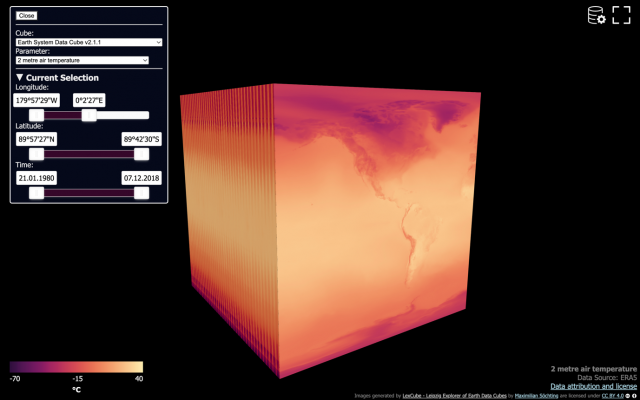ESA’s Earth System Data Lab (ESDL) has been providing a virtual lab to access a wide array of Earth observations across space, time, and variables. It consists of two elements: a data cube and an interface to execute a variety of analyses on the data cube.
The new recently launched follow-on project, called DeepESDL, will enrich the virtual laboratory with new features, data, and capabilities, turning it into an enhanced collaborative, AI-ready Earth System Science Lab, fully open to the scientific community.
At the same time, the University of Leipzig has been developing a new forward-looking visualization tool – called LexCube – to better explore the wide collection of variables available in the ESDL.
This is just a first step towards providing new ways to visually interact with multivariate datacubes and unravel Earth System processes and dynamics.
Acknowledgements
LexCube was created in the framework of a PhD project by Maximilian Söchting, advised by Gerik Scheuermann and Miguel Mahecha from Leipzig University, as a cooperation of the Image and Signal Processing Group (Inst. of Computer Science) and Earth System Data Sciences group (Remote Sensing Centre for Earth System Research).
The project was supported by the National Research Data Infrastructure for Earth System Sciences NFDI4Earth (pilot projects), the German Science Foundation (DFG), and the European Space Agency (ESA) via the DeepExtremes and DeepESDL projects.
Images generated by LexCube – Leipzig Explorer of Earth Data Cubes by Maximilian Söchting are licensed under CC BY 4.0.
Featured video : LexCube on the move. In this visualization, data cubes are displayed as space-time cubes with the time axis extending into the background. For more information on the data cube concept, see Earth System Data Cubes Unravel Global Multivariate Dynamics by Mahecha et al. (2020). All data was postprocessed and merged in the Earth System Data Cube v2.1.1 as part of the ESA (Deep) Earth System Data Lab project.

